Synthesis, Physico-Chemical and Antidiabetic Studies of Zinc Complex of Glimepiride, an Oral Hypoglycemic Agent
George Jacob
“Blyth Academy, Department of Science, Lawrence Park, 3284, Totonto, Ontario, Canada.
DOI : http://dx.doi.org/10.13005/ojc/290410
Article Received on :
Article Accepted on :
Article Published : 14 Jan 2014
The synthesis and characterization of Zinc complex with glimepiride (an oral antidiabetic drug) has been studied. The conductometric titration using monovariation method indicates that complex is non-ionic and of ML2 type. Analytical data agrees with the molecular formula (C24H34N4O5S)2 Zn. Structure of the complex was assigned as tetrahedral in which ligand molecules lies horizontally joining the central zinc atom. IR, NMR, Mass spectral and X-ray studies confirm the co-ordination of sulphonyloxygen on one side and enolic oxygen attached from other side with the metal ion. Tentative structure for complex was proposed on the basis of analytical data and Elemental analysis.
KEYWORDS:Synthesis; Characterization; Glimepiride-metal ion complex; Infrared spectroscopy
Download this article as:| Copy the following to cite this article: Jacob G. Synthesis, Physico-Chemical and Antidiabetic Studies of Zinc Complex of Glimepiride, an Oral Hypoglycemic Agent. Orient J Chem 2013;29(4) |
| Copy the following to cite this URL: Jacob G. Synthesis, Physico-Chemical and Antidiabetic Studies of Zinc Complex of Glimepiride, an Oral Hypoglycemic Agent. Orient J Chem 2013;29(4). Available from: http://www.orientjchem.org/?p=1592 |
INTRODUCTION
Glimepiride 1-(p-(2-(3-ethyle-4-methyl-2-oxo-3-pyroline-1-carboxamido)ethyl)phenyl sulfonyl)-3-(trans-4-methylcyclohexyl) Urea is a third generation hypoglycemic sulfonylurea, which is useful in the treatment of non-insulin dependent diabetesmellitus (NIDDM)1-2. Glimepiride is a white crystalline powder, relatively insoluble in water. It exhibits slow gastrointestinal absorption rate and inter individual variation of its bioavailability.3
The slow absorption rate of drug usually originates from either poor dissolution of drug from the formulation or poor permeability of drug across gastrointestinal membrane. For poorly water soluble and highly permeable drugs the rate of oral absorption is often controlled by the dissolution rate in the gastrontestinal tract4. Complexation of sulfonylurea with lighter transition metal has been studied in detail by Yoshinaga and Yamamotto (1966)5, Qureshi and Iqbal (1985)6. A persual of available literature shows that systemic study on complexation of zinc with sulphonyl ureas is relatively scanty.7-10 The study of chemistry and chemical reaction of structure co-ordination compound helps in establishing structure activity relationship. It has been reported that in biological activity metal complex is more potent and less toxic as compared to the free ligand11. In view of the above and in continuation of our work, It is interesting to have an insight into the synthesis of zinc complex with glimepiride and to diagnose various structural aspects of the isolated complex.
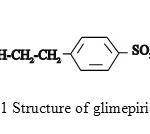 |
Fig 1 Structure of glimepiride Click here to View figure |
Ligand-metal ratio
To confirm the ligand metal ratio, conductometric titrations using monovariation method were carried out at 27 10C 0.005M solution of glimepiride drug was prepared in 80:20 mixture of DMF and water. Similarly solution of metal salt Zncl2 was prepared in the same solvent of 0.01M concentration. 20mL of ligand was diluted to 200ml with the same solvent. The ligand was titrated against metal salt solution using monovariation method. Conductance was recorded after each addition, Graph is plotted between corrected conductance and volume of metal salt added (Fig II). From the equivalence point in the graph it has been concluded that the complex formation has taken place in the ratio of 2:1 (L:M). Stability constant and free energy changes were also calculated using Job’s method8 of continuous variation modified by Turner and Anderson13 (Fig III).
CONDUCTOMETRIC TITRATION MONOVARIATION METHOD GLIMEPIRIDE WITH ZINC CHLORIDE
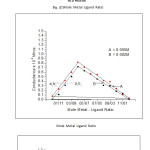 |
Fig. (II)Mole Metal Ligand Ratio Click here to View figure |
EXPERIMENTAL
All chemicals used were of analytical grade. Pure sample of Glimepiride (Molecular fornula C24H34N4O5S and mol.wt 490.62) was obtained from Ipca laboratories Ltd, Ratlam in powdered form m.p 2070C.
Metal salt Zncl2 was of merck chemical. The solvent used were distilled water and DMF. Metal-ligand ratio was calculated using Systronics Digital Conductivity meter. Melting point was determined by Parkin Elmer melting point apparatus and are uncorrected pH values determined on LabIndia pH Analyser.
Synthesis
Complex was synthesized by mixing the solution (80% DMF) metal salt solutions with that of ligand in 1:2 molar ratios; respectively at room temperature maintaining the pH between (6.5-8) by the addition of dilute NaOH solution. On refluxing the mixture content for 3hrs at 800C and on cooling the off white coloured crystals were obtained.14-17 Thecomplex was washed with 80% DMF or alcohol and weighed (yield-52%).
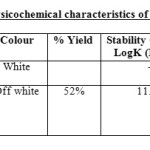 |
Table–1: Synthesis and Physicochemical characteristics of Glimepiride-Zinc complex. Click here to View table |
Analysis of Complex
The resulting complex so formed was characterized by its elemental analysis, physical characteristics, IR, NMR Mass spectral and X-ray diffraction studies.
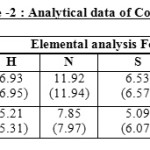 |
Table -2 : Analytical data of Complex Click here to View table |
RESULTS AND DISCUSSION
The synthesized complex is offwhite and stable, being soluble in DMSO, acetone and insoluble in water, ethanol etc. Analytical data (table 2) and conductometric studies suggest 2:1 (L:M) ratio. Measured conductance values of these complex are too low to account for their electrolytic behaviour.
Structure Determination
IR ABSORPTION STUDIES
The IR spectrum18-21 of the ligand and the isolated complex were recorded in the range 4000-450 cm-1 and the probable assignments are given in (table 3). The proposed structure for the isolated complex is also supported by IR absorption bands and characterized by the absorption of carbonyl (C=O) and sulphonyl urea group at 1701 cm-1 and 1216 cm-1 respectively. The NH group observed at 3681 cm-1 in the ligand (glimepiride) was shifted to 3752 cm-1 in Zinc glimepiride complex. The next IR band of structural significance of the ligand appears at 1656 cm-1 which may be assigned to u (C-O), which was absent in pure ligand and the considerable frequency of u (C=N) was obtained at 1542 cm-1 in metal complex while absent in pure ligand were indicates that these specific IR absorptions are appeared due to complexation. The linkage through amide-O and sulphone –O- atom was further supported by the appearance of aband in the far IR region at 670cm-1 in the complex that may be assignable to M-O frequency (Fig IV a&b).
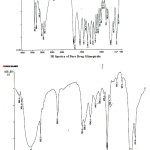 |
IR Spectra of Pure Drug Glimepiride IR Spectra of Glimepiride-Zinc complex Click here to View figure |
IR Spectra of Glimepiride-Zinc complex
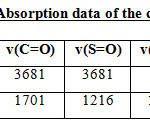 |
Table -3 : IR Absorption data of the complex in cm-1 |
H1NMR SPECTRAL ANALYSIS
1H NMR spectra of Glimepiride and its Zinc
For pure ligand Glimepiride.
(300 MHZ, Acetone)
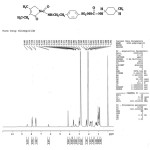 |
Click here to View figure |
Table 6
1HNMR spectral data of pure drug
| 8.44 (S, 1H NHCO), 7.94 (d, benzene J = 0.97 HZ), 7.53 (d, benzene J = 1HZ), 6.23 (S, SO2NH J = 0.39 HZ), 4.1(Se, CH2N J = 0.994), 3.61 (S, Pyrollidine), 3.33(t, CH2 attached with benzene J = 0.60), 3.02 (q, CH2 attached with carbonyl, J = 21.83), 2.21(p, CH2 attached with methyl J = 1.43HZ), 1.65 (t, CH2 attached with cyclohexane J = 1.36 HZ) 1.04(t, CH3 group, J = 2.82 HZ). |
s = singlet , d = doublet, t = triplet, q = quatrate
Glimepiride –Zinc Complex.
(300 MHZ, Acetone)
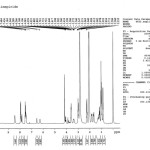 |
Click here to View figure |
Table 7
1HNMR spectral data of Glimepiride-Zn complex.
| 8.43 (S, 1H NHCO), 7.94 (t, benzene J = 2.81 HZ), 7.45 (q, benzene, J = 3.88 HZ), 6.28 (S, SO2NH, J = 0.80 HZ), 4.1 (Se, CH2N. J = 3.45 HZ), 3.72 (S, NHCO-Zn, J = 0.82 HZ), 3.61 (S,pyrollidine), 3.32(m, CH2 attached with benzene, J = 1.37HZ), 3.06 (q, CH2 attached carbonyl J = 4.33 HZ), 2.21 (p, CH2 attached with methyl J = 3.93 HZ), 1.64 (S, CH2 attached with cyclohexane, J = 2.76 HZ) 1.04 (t, CH3 group j = 7.99 HZ). |
s = singlet d = doublet t = triplet q = quatrate
The -1HNMR spectrum of the ligands Glimepiride and its isolated complex zinc were scanned through bruker DRX-300 NMR spectrometer from DCRI Lucknow using deuterated acetone as a solvent (table 4). In the spectra of glimepiride-zinc complex (table 5) exhibit a broad singlet signal at 8043 ppm, shows a down field shift, Dd for NH in NHCO group ( 8.44 ppm) in pure ligand22-24.
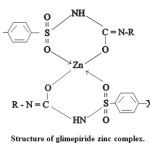 |
Structure of glimepiride zinc complex. |
Structure of glimepiride zinc complex.
CONCLUSION
The differences in melting point of metal-ligand complex as compared to Glimepiride suggested that a new product was formed. The shifts of peaks in IR region as well as new signals around at X-ray diffractogram in X-ray studies further confirmed the drug metal complexation. The tentative structure of the complex are further supported by Mass spectral analysis. The overall studies indicate the glimepiride metal complex is non-ionic and have tetrahedral geometry.
REFERENCES
- Ammar, H.O., Salama, H.A., Ghorab, M., and Mahmoud, A.A., Asian J. Pharm. Sci., 2(2)., 44-55 (2007).
- Massimo, M.B., Clin Ther., 25., 799-816 (2003).
- Kouichi et al., Diab. Res. Clin. Pract., 68., 250-57 (2005).
- Geinsen, K., Drug Res., 38., 1120-30 (1988).
- Yoshinaga I., and Yamamotto, Y., J. Osaka., 1., 3(1966).
- Iqbal, S.A., and Qureshi, R., Asian .J. Expt. Sci.,1., 68-70 (1985).
- Baliar, S., Biswal, S., Sahoo, J., and Murthy, P.N., Inter .J. Pharm. Sci and Nanotech., 2., 1129 (2009).
- Montazeri, N., Pourshamsian, K., Fouladi, M., and Bayazi, M., Orient .J. Chem., 28(1)., 399-404 (2012).
- Kelode, S.R., and Nandlik, P.R., Orient .J. Chem., 28(3)., 1213-18 (2012).
- Ghashang, M., Orient .J. Chem., 28(3)., 1213-18 (2012).
- AL-Duby, S., and AL-Jibori, S.A., Orient .J. Chem., 28(2)., 781-86 (2012).
- Job, P., Ann. Clin., 113., 10 (1928).
- Turner, S.E., and Anderson, R.C., J. Am. Chem. Soc., 912., 71 (1949).
- Iqbal, S.A. and Jacob, G., Orient. J. Chem., 23(3)., 1123-26 (2007).
- Iqbal, S.A., Jose, S., and Zaafarany, I., Orient. J. Chem., 28 (1)., 613-18 (2012).
- Nakamoto, K., “Infra-red spectra of inorganic and co-ordination compound. John Wiley & Sons, Newyork (1963).
- Bellamy, L.J., “The infrared spectra of complex molecules”. Methven & Co. Ltd. London (1954).
- Dyer, J., “Application of Absorption Spectroscopy of Organic Compounds” Prentice Hall of India Pvt. Ltd. Fourth printing., 36 (1978).
- Rao, C.N.R., “Chemical Application of Infrared spectroscopy”. Academic Press, Newyork 258 (1970).
- Chandran, A., Varghese, H.T., Yohannan, C., and Rajendran, G., Orient. J. Chem., 27(2)., 611-17 (2011).
- Tawkir, M., Iqbal, S.A. Krishan, B., and Zaafarany, I., Orient. J. Chem., 27 (2)., 603-09 (2011).
- Iqbal, S.A., Jose, S., and Xaafarany, I., Orient .J. Chem., 28(1)., 613-18 (2012).Oliveira, G.G.G., Ferraz, H.G., and Matos, J.S.R., J. Therm. Anal. Colorimetry., 29., 267-70 (2005).
- Khan, M.R., and Sahdev., Orient. J. Chem., 27(2)., 649-53 (2011).
- Santhi, S., and Namboori, C.G.R., Orient. J. Chem., 27(3)., 1203-08 (2011).

This work is licensed under a Creative Commons Attribution 4.0 International License.









